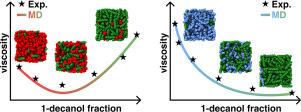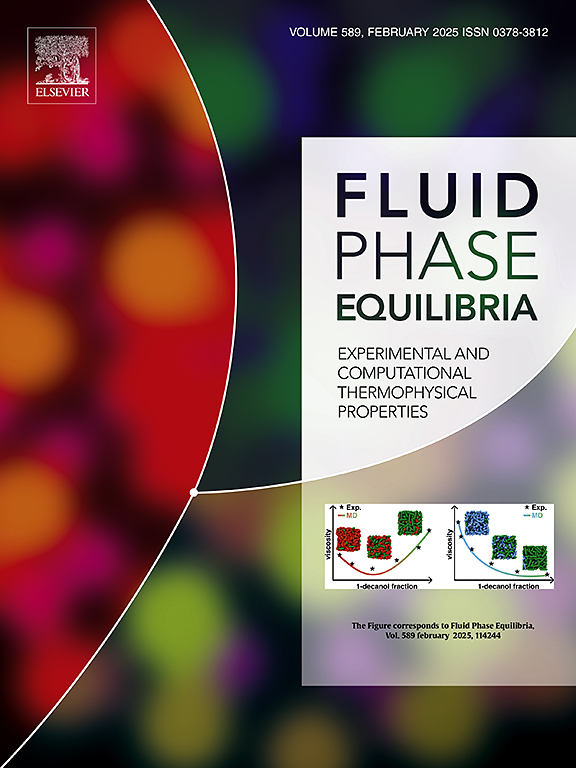Predicting viscosity-concentration dependencies of binary organic mixtures using molecular dynamics methods
IF 2.8
3区 工程技术
Q3 CHEMISTRY, PHYSICAL
引用次数: 0
Abstract
The shear viscosity of organic liquids is very important for industrial applications. This paper focuses on the blind prediction of concentration-viscosity dependencies for organic mixtures at 298.15 K and 1 bar using molecular dynamics methods. Two mixtures are considered: tributyrin+1-decanol and 1,2-butanediol+1-decanol. The interatomic interactions are described using the COMPASS force field, which is modified for the reproduction of pure compound viscosities. The Green–Kubo method is used to calculate the shear viscosities. Our approach provides accurate predictions for the viscosities of mixtures with a relative mean absolute error below 10%. This work is devoted to the participation in the 12th Industrial Fluid Properties Simulation Challenge.

利用分子动力学方法预测二元有机混合物的粘度-浓度相关性
有机液体的剪切粘度对工业应用非常重要。本文的重点是利用分子动力学方法,对 298.15 K 和 1 bar 下有机混合物的浓度-粘度依赖关系进行盲预测。本文考虑了两种混合物:三丁炔+1-癸醇和 1,2-丁二醇+1-癸醇。原子间的相互作用使用 COMPASS 力场进行描述,为再现纯化合物的粘度对其进行了修改。格林-久保法用于计算剪切粘度。我们的方法可以准确预测混合物的粘度,相对平均绝对误差低于 10%。这项工作是为了参加第 12 届工业流体特性模拟挑战赛。
本文章由计算机程序翻译,如有差异,请以英文原文为准。
求助全文
约1分钟内获得全文
求助全文
来源期刊

Fluid Phase Equilibria
工程技术-工程:化工
CiteScore
5.30
自引率
15.40%
发文量
223
审稿时长
53 days
期刊介绍:
Fluid Phase Equilibria publishes high-quality papers dealing with experimental, theoretical, and applied research related to equilibrium and transport properties of fluids, solids, and interfaces. Subjects of interest include physical/phase and chemical equilibria; equilibrium and nonequilibrium thermophysical properties; fundamental thermodynamic relations; and stability. The systems central to the journal include pure substances and mixtures of organic and inorganic materials, including polymers, biochemicals, and surfactants with sufficient characterization of composition and purity for the results to be reproduced. Alloys are of interest only when thermodynamic studies are included, purely material studies will not be considered. In all cases, authors are expected to provide physical or chemical interpretations of the results.
Experimental research can include measurements under all conditions of temperature, pressure, and composition, including critical and supercritical. Measurements are to be associated with systems and conditions of fundamental or applied interest, and may not be only a collection of routine data, such as physical property or solubility measurements at limited pressures and temperatures close to ambient, or surfactant studies focussed strictly on micellisation or micelle structure. Papers reporting common data must be accompanied by new physical insights and/or contemporary or new theory or techniques.
 求助内容:
求助内容: 应助结果提醒方式:
应助结果提醒方式:


